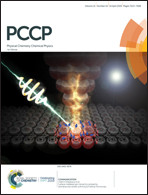Ionic conductivity of solid polyelectrolyte complexes with varying water content: application of the dynamic structure model†
Abstract
We present a systematic study of the dc conductivity of solid polyelectrolyte complexes (PEC) of type xPSS PSS·(1 − xPSS) PDADMA as a function of temperature, and of PSS and water content, respectively. PSS stands for poly(styrenesulfonate) and PDADMA for poly(diallyldimethylammonium). Apart from these polyions, small ions like Na+ and Cl− can be incorporated into the complexes. The amount of small ions and its type (Na+ or Cl−) depend on the PEC composition. We show that, in contrast to dried polyelectrolyte complexes where the chloride ions are macroscopically immobile, Cl− ions become mobile if water is absorbed into the PEC. In PEC with an excess of PDADMA (xPSS < 0.5), hydrated Cl− ions govern the ionic conductivity. On the other hand, in PEC with an excess of PSS (xPSS > 0.5), the conductivity is determined by the sodium ions. For the first time we show that the dependence of the conductivity on composition can be described by power-laws as derived within the framework of the dynamic structure model originally developed for glassy ion conductors by Bunde, Ingram and Maass (J. Non-Cryst. Solids, 1994, 172–174, 1222). This power-law behavior is found in PEC with an excess of Cl− ions as well as in those with an excess of Na+ ions. Also the model predictions concerning the temperature dependence of the power-law exponents on the one hand and the composition dependence of the activation enthalpy on the other hand, are found to be valid. These findings indicate that in polyelectrolyte complexes ions travel via pathways of ion specific sites through the polyelectrolyte matrix. The results on hydrated PEC are compared to those of dry PEC where the dynamic structure model is only applicable for PEC with an excess of PSS (xPSS > 0.5).

- This article is part of the themed collection: 2019 PCCP HOT Articles


 Please wait while we load your content...
Please wait while we load your content...